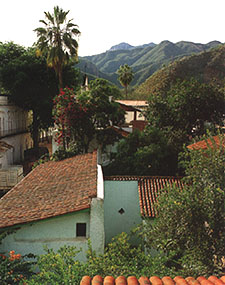|
Batopilas

Batopilas' local church |
Although there were various mining centers that were formed at the bottom of some canyons, such as Urique, Maguarichi, Uruachi and Ocampo, none can compare with the mineral richness of the Batopilas Canyon. The veins of La Bufa and those of the town of Batopilas itself reached renown of a world level. Its mining towns and mines characterize and identify this canyon. Among the outstanding are La Bufa, Batopilas, Cerro Colorado, the Raramuri communities of Munérachi and La Yerbabuena, and the Jesuit mission of Satevó.
In spite of the fact that the climate is extreme in the high regions of the canyon range, in the winter it is possible to admire a curious phenomenon - while the surrounding peaks are covered with snow the depths of the canyon are a subtropical or tropical climate year around. Due to this, towns like Batopilas have flora and fauna with many different characteristics than in the Sierras above. Oranges, papaya, mango, avocado are regular staples of the habitants. Bougainvillas and tabachine (a flowering tree) are among the tropical vegetation. Animals may include parrots, rosy boas, deer, and even possibly jaguar.
|

Ruins of the Alexander Shepherd's Hacienda San Miguel

Tropical vegetation in Batopilas

The 17th century "Lost Mission" of Satevó
Today, the town of Batopilas is a community of 800 inhabitants, but in it's greatest mining period at the end of the 19th century, it had up to 7,000 inhabitants. It has preserved, to a great extent, it's architectural heritage from the richness of those times. |
A Brief Bit of History
Batopilas is considered the "Treasure of the Sierra Madre" because of it's historic past and present beauty. Founded in 1709 as San Pedro de Batopilas when the Batopilas mines were discovered, the small pueblo slowly, but steadily flourished due to this mining activity.
The Jesuit mission of San Miguel de Satevó, just outside the town, is known as the "Lost Mission" as there are no records describing it's existence. Believed to have been constructed in the 1760's, the mission is one of the canyon's best preserved. It's setting is ideal near the edge of the Batopilas River.
The silver mines of Batopilas were some of the richest in Mexico. In the 18th and 19th century both Spaniards and Mexicans gained great wealth out of the area. American John Robinson purchased an old claim in 1861 which turned out to have a large, hidden vein. He decided to sell the claim to fellow American Alexander Shepherd for $600,000 US in 1880.
Alexander Shepherd was the last mayor of Washington, D.C. and had been ousted under unproven corruption charges. Once Shepherd moved his family to Batopilas, he filed over 350 mining claims and formed the Batopilas Mining Company. His mines became some of the wealthiest in the world at their peak.
Noting the difficulty and time (over eight days) of transporting the silver ore to Chihuahua, Shepherd opened his own facilities and foundry along the river at his Hacienda San Miguel. Over 20 million ounces of silver were extracted from the mines, and this great wealth allowed Shepherd to bring cultural events and technological advances to this once sleepy town. Batopilas was the second city in Mexico to have electricty. His hydroelectric works provide the towns power still and he also built an aqueduct which is still in use today. So famous for it's wealth were Shepherd's mines that Pancho Villa once robbed a mule shipment of $40,000 US in silver bars.
Alexander Shepherd died in 1902, leaving the mines to his sons who ceased operation in 1920, although other miners would later try unsuccessfully to restart the old mines. In 1938, one son, Grant Shepherd, wrote The Silver Magnet about life in Batopilas and Alexander Shepherd. It is an excellent description about this once world famous town.
To get to Batopilas

Local miner on the road to Batopilas |
You can get here either from Creel or Guachochi, but either way you will need to take the road that connects them. At kilometer 70, take the detour to Samachique. From here it's 55 kilometers on a dirt road which descends dramatically to Batopilas giving you some of the canyon's most exceptional views. Use caution as this road has some sharp cutbacks and is rather narrow in some areas. La Bufa is the perfect spot for a commanding view of the Batopilas Canyon system.
Most visitors choose to take a tour company to the canyon's bottom, both for the safety factor of an experienced canyon driver, and for the opportunity to take photos and take in the view. Most drivers will pull over upon request. Creel is the perfect place to set up this trip.
|
|